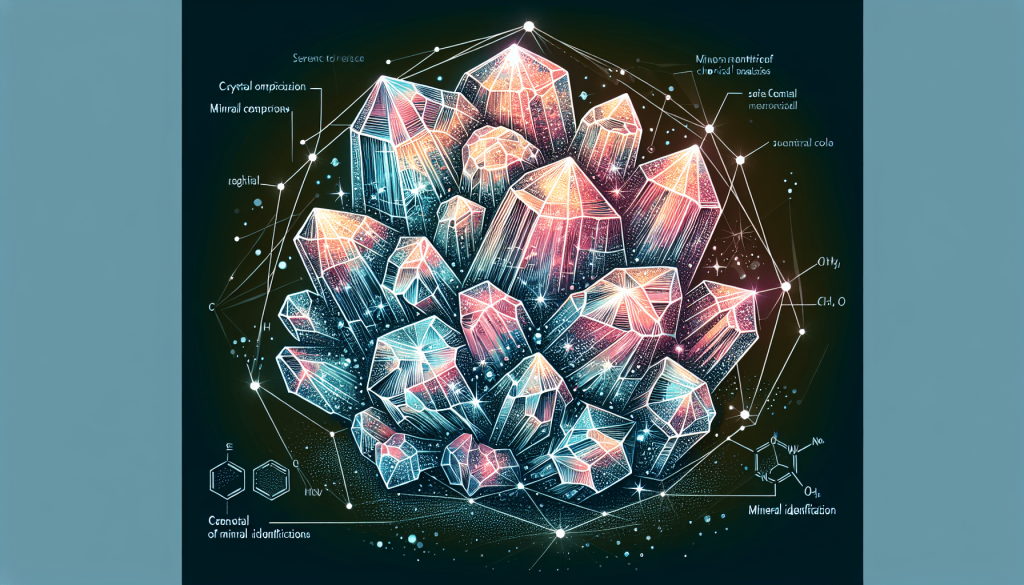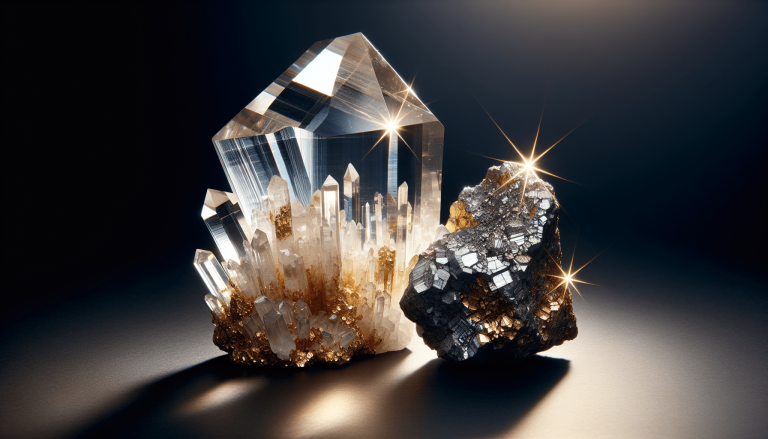Tips For Identifying Minerals Based On Their Chemical Composition
So you’re interested in learning how to identify minerals based on their chemical composition? Well, you’ve come to the right place! In this article, we’ll provide you with some useful tips and techniques that will help you become a pro at identifying minerals by analyzing their chemical makeup. Whether you’re a geology enthusiast or a student studying earth sciences, these tips will surely come in handy when examining and categorizing different minerals. So, let’s get started and dive into the world of mineral identification!
Physical Properties of Minerals
Color
Color is one of the most obvious physical properties of minerals and can vary widely. Minerals can range from white or colorless to vibrant shades of red, green, blue, and more. However, it’s important to note that color alone is not always a reliable indicator of mineral identity since many minerals can have similar colors.
Luster
Luster refers to the way light reflects off the surface of a mineral. It can be described as metallic or non-metallic. Metallic luster is shiny and reflective, like polished metal, while non-metallic luster can be further classified into categories such as vitreous (glassy), pearly, silky, or resinous. Luster can provide valuable clues in identifying minerals.
Streak
Streak refers to the color of a mineral’s powder when it is scraped against a rough surface, such as a porcelain streak plate. It may or may not be the same as the mineral’s actual color. For example, a mineral with a red color may leave a streak that is colorless or a different color. Streak is a useful diagnostic property that can help distinguish minerals.
Hardness
Hardness is a measure of a mineral’s resistance to scratching. It is determined by the mineral’s internal atomic structure. The Mohs scale is commonly used to rank mineral hardness. For example, talc is the softest mineral and is assigned a hardness of 1, while diamond is the hardest mineral and has a hardness of 10. Hardness can be tested using various materials of known hardness, such as fingernail, copper penny, or glass.
Cleavage
Cleavage refers to the way a mineral breaks along planes of weakness. It is the result of the different strengths of chemical bonds within the crystal lattice of the mineral. Cleavage can produce smooth, flat surfaces that are parallel to each other. The number and angles of cleavage planes can vary, providing valuable information for mineral identification. Some minerals have perfect cleavage, meaning they break easily along flat surfaces, while others may have poor or no cleavage at all.
Fracture
Fracture is another property related to how a mineral breaks, but unlike cleavage, it does not produce smooth, flat surfaces. Fracture refers to the texture of the broken surface and can be described as conchoidal (shell-like), fibrous, splintery, or irregular. The type of fracture can help distinguish between minerals that may have similar cleavage properties.
Density
Density is a measure of how much mass is contained in a given volume. It is calculated by dividing the mass of a mineral by its volume. Density can provide clues about the composition and purity of a mineral. For example, minerals with higher densities may contain heavier elements or have fewer impurities. Density can be determined through various methods, including the use of precision scales and displacement of water.
Chemical Composition
Understanding Chemical Formulas
Chemical formulas represent the types and ratios of elements present in a mineral. They provide crucial information about the composition of minerals. For example, the chemical formula for quartz is SiO2, which indicates that one silicon atom is bonded to two oxygen atoms. Understanding chemical formulas allows mineralogists to identify and classify minerals based on their elemental composition.
Determining Elemental Composition
Determining the elemental composition of a mineral involves analyzing the types and amounts of elements present. Techniques such as X-ray fluorescence (XRF) spectrometry and electron microprobe analysis can provide quantitative data on the elemental composition of minerals. Comparing the elemental composition with known mineral standards helps identify specific minerals and distinguish between different mineral species.

Identifying Elements in Minerals
Using Spectroscopy
Spectroscopy is a powerful technique used to identify elements in minerals. It involves analyzing the interaction between electromagnetic radiation and a mineral sample. Different elements absorb and emit specific wavelengths of light, resulting in unique spectral signatures. Spectroscopy techniques such as X-ray spectroscopy, infrared spectroscopy, and UV-Visible spectroscopy can reveal the presence of elements in minerals and aid in mineral identification.
Chemical Tests
Chemical tests are commonly used to identify specific elements or groups of elements in minerals. These tests involve subjecting mineral samples to various reagents or conditions and observing the resulting reactions. For example, the reaction of a mineral with hydrochloric acid can indicate the presence of carbonate minerals. Chemical tests provide valuable insights into the composition of minerals and aid in their identification.
Common Mineral Groups
Silicates
Silicates are the most abundant group of minerals, making up the majority of the Earth’s crust. They are characterized by the presence of silicon and oxygen, combined with other elements such as aluminum, iron, calcium, or potassium. Examples of common silicate minerals include quartz, feldspar, and mica.
Carbonates
Carbonates are minerals that contain the carbonate ion (CO3^2-) combined with other elements such as calcium, magnesium, or iron. They are commonly found in sedimentary rocks and play a crucial role in the formation of limestone and marble. Calcite and dolomite are well-known examples of carbonates.
Sulfides
Sulfides are minerals that consist primarily of sulfur combined with one or more metals. They are often associated with hydrothermal alteration and can be economically valuable due to their metal content. Pyrite, galena, and chalcopyrite are common sulfides.
Oxides
Oxides are minerals that contain oxygen combined with one or more metals. They can form under various geological conditions and play important roles in the formation of ore deposits. Examples of oxide minerals include magnetite, hematite, and rutile.
Sulfates
Sulfates are minerals that contain the sulfate ion (SO4^2-) combined with other elements such as calcium, magnesium, or aluminum. They are often found in association with other evaporite minerals and are important indicators of specific geological environments. Gypsum and barite are examples of sulfate minerals.
Halides
Halides are minerals that contain halogen elements such as chlorine, fluorine, or iodine. They often form in evaporite environments or as secondary minerals in hydrothermal systems. Halite (rock salt) and fluorite are well-known halides.
Native Elements
Native elements are minerals that occur in nature as pure, uncombined elements. They are relatively rare but can have high economic value. Well-known examples include gold, silver, copper, and diamond.

Chemical Reactions and Transformations
Acid Reactivity
Some minerals react with acid, leading to effervescence (the release of gas bubbles) or dissolution. This reactivity can indicate the presence of carbonate minerals, which react with acid to release carbon dioxide gas. The intensity and speed of the reaction can vary depending on the specific mineral and the concentration of the acid used.
Heat Reactions
Heating certain minerals can cause them to undergo physical and chemical changes. For example, minerals containing water molecules (hydrates) may lose water when heated, resulting in a change in appearance or crystal structure. Heating can also cause minerals to change color or exhibit new properties. Heat reactions can provide valuable insights into the composition and behavior of minerals.
Oxidation
Oxidation refers to the reaction of a mineral with oxygen, often resulting in a change in color or the formation of a new mineral. For example, the oxidation of iron-bearing minerals can lead to the formation of reddish-brown iron oxides. Oxidation reactions are important in weathering processes and can help identify mineral transformations that occur over time.
Crystallography
Crystal Systems
Crystal systems describe the different ways that atoms or ions are arranged in a mineral’s crystal lattice. There are seven main crystal systems: cubic, tetragonal, orthorhombic, hexagonal, rhombohedral, monoclinic, and triclinic. Each system has specific symmetry and geometric characteristics. Crystal systems, along with other physical properties, help in mineral identification.
Atomic Arrangement
The atomic arrangement within a mineral’s crystal lattice determines its crystal system and other properties. Minerals can have a variety of atomic arrangements, ranging from simple repeating patterns to complex structures. Understanding the atomic arrangement is vital for identifying and classifying minerals.
X-ray Diffraction
X-ray diffraction is a technique used to study the crystal structure of minerals. X-ray beams are directed at a mineral sample, and the resulting diffraction pattern is analyzed to determine the arrangement of atoms in the crystal lattice. X-ray diffraction is widely used in mineralogy and helps identify minerals based on their unique crystal structures.
Mineral Identification Tools
Use of a Hand Lens
A hand lens, also known as a loupe, is a portable magnification tool that can be used to examine minerals in detail. It allows for closer inspection of mineral features such as color, luster, and crystal shape. A hand lens with a higher magnification (10x or higher) is particularly useful for observing small details and mineral textures.
Polarizing Microscopes
Polarizing microscopes are specialized optical instruments used to study minerals in thin sections. Thin sections are slices of rock or mineral that are mounted on glass slides and ground to a thickness of about 30 microns. Polarizing microscopes use polarized light to examine the optical properties of minerals, such as their birefringence and interference colors.
Chemical Testing Kits
Chemical testing kits contain a variety of reagents and tools for performing basic chemical tests on minerals. These tests can help identify specific minerals or groups of minerals based on their reactions to different reagents. Commonly included tests include acid tests, which can detect the presence of carbonates, and magnet tests, which can indicate the presence of magnetic minerals.
Mineral Identification Apps
With advancements in technology, mineral identification apps have become popular tools for amateur and professional mineralogists alike. These apps use image recognition algorithms, databases, and built-in tools to help identify minerals based on photographs or characteristics inputted by the user. While not always as accurate as expert analysis, these apps can serve as valuable aids in the field.
Recognizing Common Minerals
Quartz
Quartz is one of the most abundant minerals on Earth and is known for its hexagonal crystal shape and glassy luster. It comes in a variety of colors, but the most common variety is colorless or white. Quartz is resistant to scratching and has a hardness of 7 on the Mohs scale. It is often used in various industries, including electronics and jewelry.
Feldspar
Feldspar is a group of minerals that make up a significant portion of the Earth’s crust. They are known for their typically pink, white, or gray colors and a pearly or vitreous luster. Feldspars have a hardness of 6 on the Mohs scale and can be cleaved into flat, rectangular-shaped pieces. They are commonly used in ceramics and glassmaking.
Calcite
Calcite is a carbonate mineral that is often transparent or translucent and exhibits a rhombohedral crystal shape. It has a white streak and can effervesce when in contact with weak acid. Calcite has a hardness of 3 on the Mohs scale and is widely used in construction, as a soil conditioner, and as a source of calcium carbonate.
Magnetite
Magnetite is an oxide mineral that is strongly magnetic, earning its name. It is usually black or dark gray and has a metallic luster. Magnetite is commonly found in igneous and metamorphic rocks and is an important source of iron. It has a hardness of 5.5-6.5 on the Mohs scale and can be attracted to a magnet.
Pyrite
Pyrite, also known as “fool’s gold,” is a sulfide mineral that often forms cubic crystals and has a metallic luster. It is typically brassy yellow in color and has a greenish-black streak. Pyrite has a hardness of 6-6.5 on the Mohs scale and is known for its ability to spark when struck against a hard surface. It is often mistaken for gold due to its appearance.
Gypsum
Gypsum is a sulfate mineral that is commonly found as transparent to translucent crystals or mass. It has a pearly luster and can exhibit various colors, including white, gray, and pink. Gypsum has a hardness of 2 on the Mohs scale and is easily scratched with a fingernail. It is widely used in construction, as a fertilizer, and in the production of plaster.
Halite
Halite, or rock salt, is a halide mineral that is often colorless or white and has a cubic crystal shape. It has a salty taste and is water-soluble. Halite has a hardness of 2-2.5 on the Mohs scale and is widely used as a seasoning and in the production of various chemicals, including table salt.
Diamond
Diamond is a native element and is the hardest known natural substance, ranking 10 on the Mohs scale. It is famous for its exceptional brilliance and is typically colorless, although it can occur in various colors. Diamonds are formed deep within the Earth’s mantle under high pressure and temperature conditions. They are highly valued as gemstones and are commonly used in jewelry.
Importance of Identifying Minerals
Geological Research
Identifying minerals is crucial in geological research. The composition and properties of minerals provide valuable information about the geological processes that formed them and the environments in which they occur. By studying minerals, geologists can gain insights into the formation of rocks, the history of Earth’s processes, and the potential for natural resource exploration.
Industrial Applications
Identifying minerals is essential for various industrial applications. Different minerals have unique physical and chemical properties that make them suitable for specific uses. For example, quartz is used in the production of glass and silicon for electronic devices, while feldspar is used in ceramics and glassmaking. Knowledge of mineral identification helps industries select and utilize appropriate materials for their processes.
Understanding Geological Processes
Mineral identification plays a key role in understanding geological processes. By examining the characteristics of minerals present in rocks or sediments, geologists can determine the conditions under which they formed. This knowledge helps unravel the geological history, such as the evolution of mountain ranges, the deposition of sedimentary layers, or the timing of volcanic eruptions. Identifying minerals aids in reconstructing Earth’s past and understanding the forces that shape our planet.
Safety Considerations
Handling Minerals Safely
When handling minerals, it is important to take safety precautions. Some minerals may have sharp edges or contain toxic elements. It is advisable to wear appropriate protective gear, such as gloves and safety glasses, when handling rough or sharp mineral specimens. Additionally, it is important to handle minerals with care to prevent accidental breakage or injury.
Avoiding Toxic Minerals
Certain minerals may contain toxic elements, such as lead or arsenic. It is important to be aware of potential health hazards associated with specific minerals and handle them accordingly. Minimize direct skin contact, avoid inhaling mineral dust, and wash hands thoroughly after handling potentially toxic minerals. Proper education and knowledge of mineral safety are essential for minimizing risks and ensuring a safe mineral collection.







